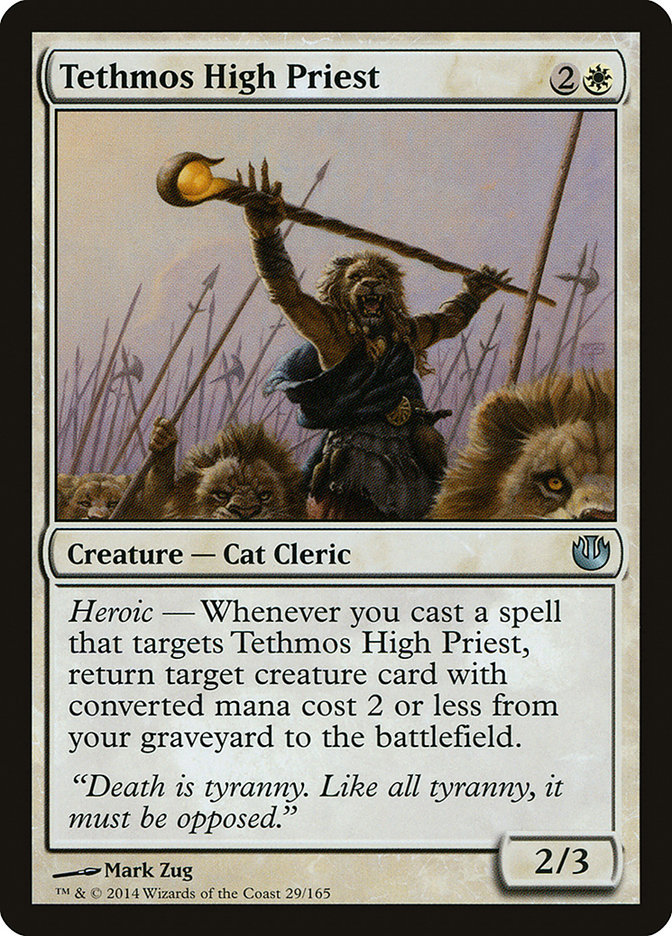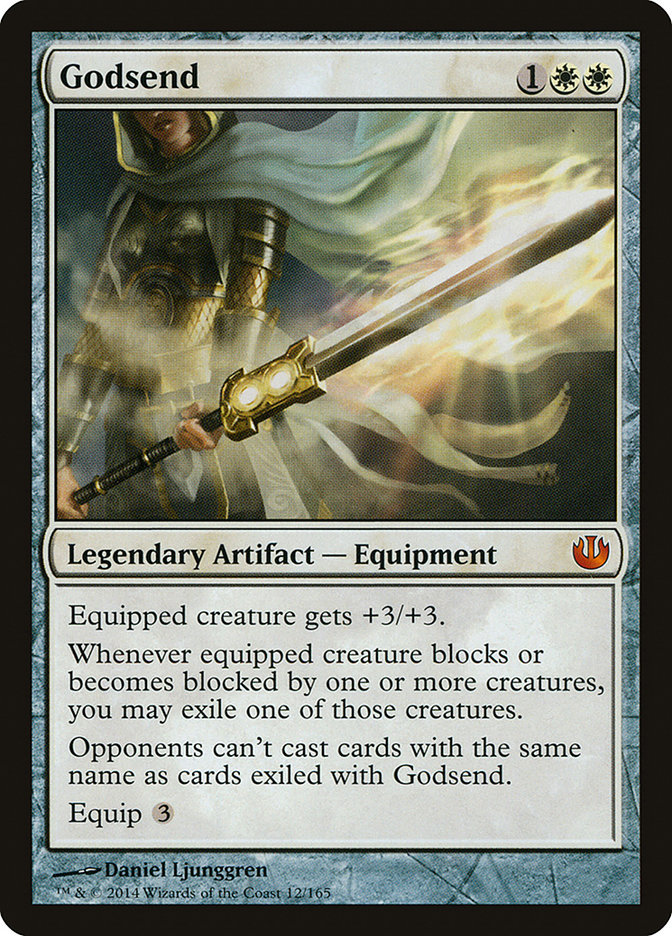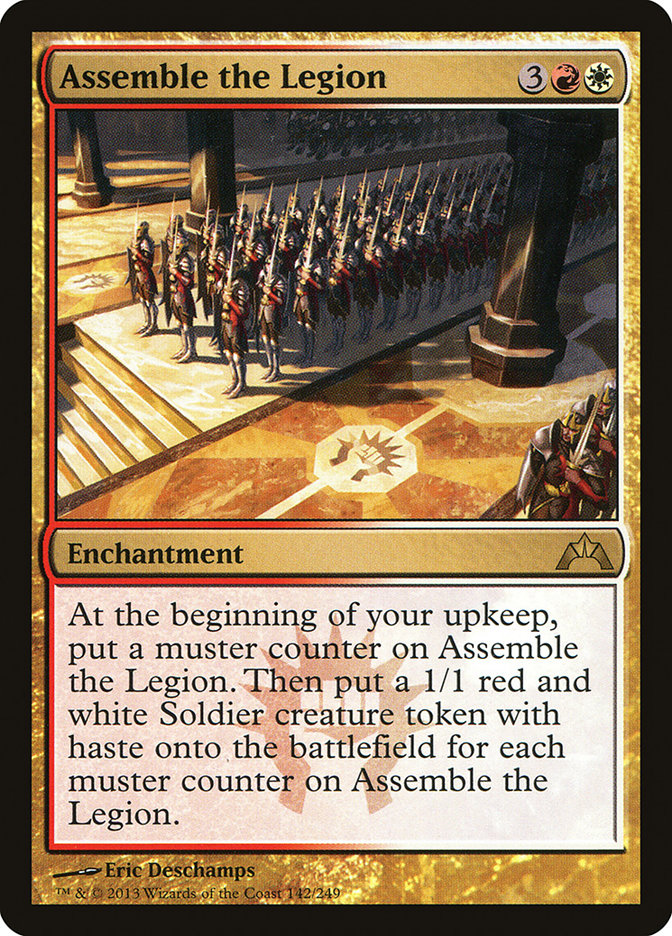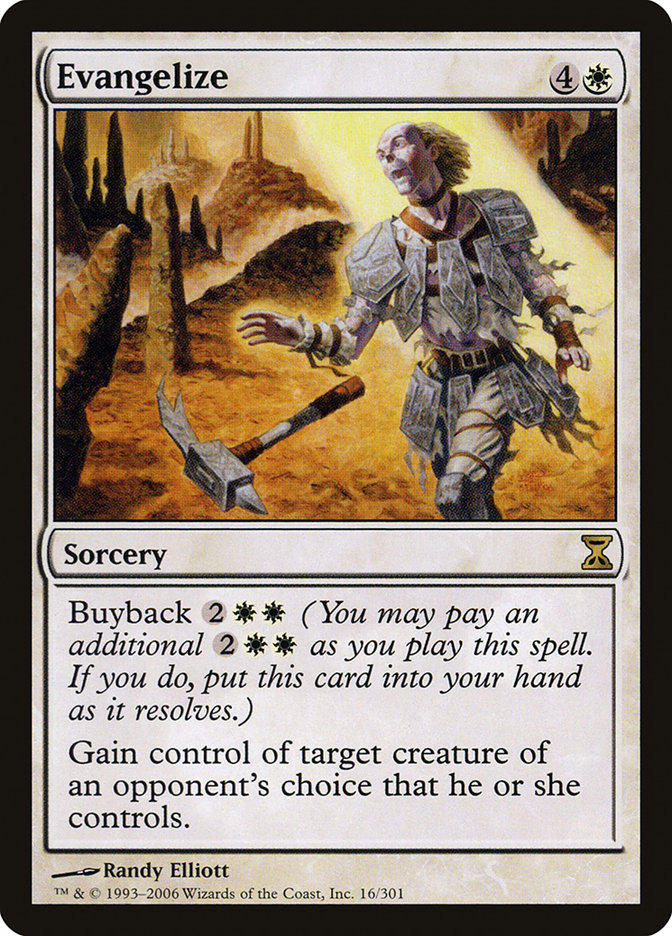I’m having a bit of an identity crisis.
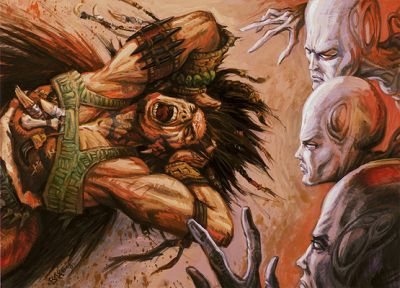
White has always been my least favorite color. I never liked the “unity/protection” flavor theme of white, and the cards felt very one-note to me. The
swarms of tokens, the lifegain, the combat tricks; they never quite struck a nerve. I’m sure everyone’s had a friend that played a Soldier or Cleric deck
or a lock-out-style deck with a bunch of life gain cards. They may not win normally, but boy they’ll make you concede when they pass 100 life! This was
always how I saw white, and until Theros Block, that hadn’t changed.
Theros has brought several intriguing, fun, and flavorful spells to white mages, and Journey into Nyx sports two that are particularly enticing. The first
is an unusual, heroic-triggered kitty that provides the potential to recover a fallen soldier for you, even in the heat of battle.
Out of all the uncommons from Journey into Nyx, the High Priest is one of the more unusually bubbly (brew-able) ones. 2/3s for three are par for the course
these days for white, and getting an extra ability is routine, too. Tethmos offers an aggro deck a chance to recover a dead teammate to keep the pressure
on.
We’ve seen this ability before, and it didn’t do much then, and it was a free
trigger, so when I buckled down to earn the High Priest’s blessing, the bar was set fairly low.
Moreover, using Tethmos High Priest as a serious card has two unrelated, but essential problems:
1. Unlike other cards like it, Tethmos High Priest doesn’t ferry the dead for free.
Heroic as an ability is a bit tricky. Once you have a mediocre creature out with a heroic ability, you must commit time, mana, and an additional card to
trigger its ability. The threshold of good heroic cards is pretty stark, and Tethmos High Priest hovering on the cusp of playability by that standard, the
deck must center around its trigger.
2. It’s not Brimaz, King of Oreskos.
So long as you’ve got a set of His Royal Cat-jesty, you’ll want to play him in this same, three-mana slot any time. You get an extra +1/+1, vigilance, and
a free triggered ability, potentially even twice per turn. The High Priest takes extra spells, while Brimaz recruits Soldiers just be charging into battle.
Both of them die to Mizzium Mortars, Hero’s Downfall, etc., so you want to make it count when they resolve, right?
So Tethmos High Priest has the potential to pull from the pool of one- and two-drops available in Standard.One of the format’s best two-drops comes to mind, and althoughI considered other all-stars in the format, Voice of Resurgence kept coming back to mind.
Green and white each offered nifty two-drops, so I hovered there.
So how do we trigger heroic? Although it seems obvious now, it took a second to put together the possibility of bestow creatures as the creature base. As
opposed to the potentially one-and-done nature of spells, bestow creatures could have several lives, first as an Aura, then as a creature, then as a
resurrected creature. With that in mind, there’s probably some breathing room to highlight some of the block’s more atypical choices.
Creatures (28)
- 4 Voice of Resurgence
- 4 Fleecemane Lion
- 4 Soldier of the Pantheon
- 4 Hopeful Eidolon
- 4 Hero of Iroas
- 4 Sightless Brawler
- 4 Tethmos High Priest
Lands (22)
Spells (10)
Sideboard

Creatures
Hopeful Eidolon and Soldier of the Pantheon make up the one-drops. Although you’ll rarely cast Hopeful Eidolon on turn 1, it’s an excellent, on-curve
target for the High Priest. Soldier of the Pantheon will always have the upper hand over Dryad Militant, if you can only pick one Savannah Lions. On two,
Hero of Iroas offers another tempting bestow target while also shrinking the frequently lofty costs of casting a creature as an enchantment. This leads me
to Sightless Brawler.
Sightless Brawler, in my mind, is on par with Daring Skyjek. Daring Skyjek, also a 3/x for 2, frequently can’t attack unless it’s attacking with a group.
Sightless Brawler sacrifices the evasive nature of the flying Knight to offer the option to suit up an interesting target, whether it’s one of your own
creatures or if you’re facing down a singular threat. Fleecemane Lion and Voice of Resurgence appear as our haymakers; Voice is still stubborn to kill
outside of Banishing Light and friends or a timely Anger of the Gods. Fleecemane Lion, if you didn’t know, is nearly impossible to beat once it’s become
monstrous. Slap a Hopeful Eidolon on there, and your opponent will scoop before you blink.
The High Priest himself is on top, and it was intentionally left on the top of the curve. Although there’s an argument that you could play it and/or some
number of Brimaz, King of Oreskos, but for the purposes of tidiness, consistency, and theme, we’ll play the full set. It’s easy to cast it with an instant
up to protect it, so it’ll often be right to cast it on four.
The spells are much simpler. Gods Willing is relatively interchangeable with Ajani’s Presence, a spell I’ve fiddled around with and enjoyed each time I
cast it, whether it’s for the small but effective pump, for its indestructibility feature, or just to get that heroic trigger. Gods Willing protects your
target from nearly everything but a non-targeted sweeper spell and, in the end, I preferred the blanket of protection (or evasion, if you’d rather) over
the mini-Boros Charm. This can be adjusted based on your metagame; if you play against a lot of Supreme Verdicts and/or Elspeth, Sun’s Champion, you might
like having a mix of the two spells. Selesnya Charm functions as the deck’s removal for problem creatures. Desecration Demon and Thassa, God of the Sea
still have the potential to terrorize any deck, so it’s best to come prepared. It has the potential to trigger heroic or provide a vigilant token for
enchantment. Acolyte’s Reward is a little pet card of mine; Carom was always fun, and redirect effects often have hilarious consequences. In oddball
circumstances, you can also use it to target two creatures you control to trigger heroic twice. Although the devotion in this deck isn’t too high, it
should be sufficient to do the job.
The landbase is straightforward, and because most spells require a decent level of colorless mana, a suite of four Mutavaults seemed acceptable.
The sideboard is pretty simple too. Keening Apparition, a card that is both gaining traction and gaining a lofty misspell tally from yours truly, slots in
as a really nice four-of. It can off itself on command, meaning that Tethmos High Priest’s Trigger can effectively mean, “Destroy the next good enchantment
your opponent plays.” Ethereal Armor and Unflinching Courage come in without hesitation against the aggro deck. Both provide sufficient strength and
synergy to keep an unprepared mono-colored deck on its toes. Finally, Aegis of the Gods offers protection against Thoughtseize, Rakdos’s Return, and even
Devour Flesh. Its two-drop status means it can also be reanimated by the High Priest, which is particularly handy in response to a targeted spell.
I went to sling this in the Tournament Practice room and earned these results.
U/W Control – 2-1
Mono-Red – 2-0
Black/White Humans 1-2
Jund – 0-2
B/R Aggro – 2-0
W/R Burn – 1-2
Against the first control deck, I enjoyed the speed of the slender creatures and a Sphinx-less draw on my opponent’s part to snag two resounding wins.
Mono-Red was a piece of cake; Voice of Resurgence is very tough to beat, and copious amounts of early blocking followed by a recursion of those same
blockers meant a clean finish. From there, I fought and beat a B/W Humans list in the first game, but the combination of Cartel Aristocrat and Xathrid
Necromancer proved too much for me. Jund crushed me, resolving creatures that were larger and more efficient than mine. B/R Aggro proved to be a non-match,
receiving an instant concession in game two after he Doom Bladed my Voice on my turn for two 2/2s. W/R Burn slipped in the first game, but after sticking a
couple Chandra’s Phoenix and a timely burn spell, he sealed up games two and three in similar ways.
3-3
I enjoyed playing this deck; it is unmistakably an aggro deck, though it deals feel much more underpowered combat-wise than other white, green, red, or
black aggro decks. However, the interactions are fun and the deck has a surprising amount of staying power between bestow creatures, some recursion, and
Voice of Resurgence. I enjoyed playing it, but wait till you see what’s next.
If it says “Legendary Artifact – Equipment,” I will play it regardless. The Kaldra cycle from Mirrodin Block was a huge contributor to my Equipment
obsession, and seeing another Legendary Equipment got me excited. Godsend was dismissed early as a nifty Commander card at best or a waste of a mythic slot
at worst. Godsend was calling my name regardless, and it was important to find a deck it could reasonably call home.
Godsend, like other large equipment, functions best if it’s placed on an otherwise unthreatening creature to give it board presence. Thankfully, if it’s
little creature you want, Standard’s got several options to sate you.
This inevitable steamroller seemed like a reasonable place to start, and from there, I mashed this together.
Creatures (16)
- 4 Keening Apparition
- 2 Heliod, God of the Sun
- 4 Brimaz, King of Oreskos
- 2 Iroas, God of Victory
- 4 Nyx-Fleece Ram
Lands (24)
Spells (20)
- 2 Boros Keyrune
- 3 Assemble the Legion
- 4 Chained to the Rocks
- 2 Spear of Heliod
- 3 Anger of the Gods
- 2 Godsend
- 4 Banishing Light
Sideboard

Some of the creature base will look familiar. After enjoying Keening Apparition (I misspelled it again) in the last list, I employed a quartet here. Brimaz
takes his rightful place too, and Nyx-Fleece Ram blocks nearly anything. Two of each playable God in these colors appear; the prevalence of white devotion
means both are easily activated, and Heliod, God of the Sun can make Clerics to bear Godsend.
Banishing Light is just as good as advertised, though enchantment hate is becoming more common, so don’t trust it to cage your target forever. Chained into
the Rocks is a cheaper, more limited version and to some degree explains the inordinate number of Mountains in this mainly white deck. Anger of the Gods
has the benefit of kill non-green aggro decks, but all of my prime fighters survive its flame. Assemble the Legion appears in triplicate which I’ve found
to be the perfect number over the course of the last eighteen months. Boros Keyrune helps red/white jump over the awkward four-mana slump to resolve
Assemble the Legion on-time. It can also hold the deck’s namesake and smash for a mighty eight damage. Take that, Mutavault! Speaking of which, Godsend
finds itself with two copies and an additional two copies of Spear of Heliod, which both bear the unfortunate nature of being legendary.
Lands are uncomfortably biased towards red to take care of Chained to the Rocks and Anger of the Gods. Moreover, you’ll find no copies of colorless lands
to keep things consistent. Mutavault is pretty pointless when you’re attacking with a dozen Soldiers, and Nykthos provides little ramping potential despite
the high devotion count.
The sideboard is a bit of a wash, though Fiendslayer Paladin and Boros Reckoner both handle red/X decks very effectively, and Aegis of the Gods is another
aggressive creature or a shield for your face. Burning Earth leverages the basic land nature of the deck against the greedy, three-color bases of Jund,
Esper, and Junk lists.
I didn’t play this one quite as much as it took a bit longer than the aggro list, but here’s how it did.
Mono-Red – 2-0
Esper – 2-0
G/R Aggro – 2-1
G/W Constellation – 1-2
It was a ton of fun to play!
Godsend turned out to be a solid, albeit expensive, Vulshok Battlegear for most of my matches. Godsend was a bit weird, however; it went great with a big
creature (Heliod, God of the Sun) when attacking, and it did great on a Legion token when blocking, perennially keeping a superior force at bay. Most of
the time, it just boosted power and toughness, however.
The deck was very well-equipped against aggro and control, having enough anti-aggro burn and removal to let me establish a Legion, and there was
enough enchantment removal to destroy Esper builds designed to stop you with Detention Sphere. Though I missed not having access to draw spells, the slow,
steady nature of this deck was a blast to play. The G/W Constellation was a bit of an outlier, but the popular G/B Constellation deck would do even better,
so building for that metagame might be important.
Of the two, this one is more tournament-ready than the other, and it’s really got nothing to do with Godsend at all; Assemble the Legion is the star.
Combined with Spear of Heliod (and Hall of Triumph, if you wish), Assemble the Legion might have a home in today’s Standard. An old Naya list I made last
April tested very well, too. Changing the numbers of this build or even adding a second color can make this a fun and reasonable choice for an Open Series
or Invitational Qualifier event.
OK, flashy white spells, I think you got me.
There are several brews on the horizon, but what has been your favorite card from JOU to brew with so far? Have you even found Eternal applications for
some? Even more broadly for you Plains-lovers, what do you like about white and what brought and/or keeps you there?


